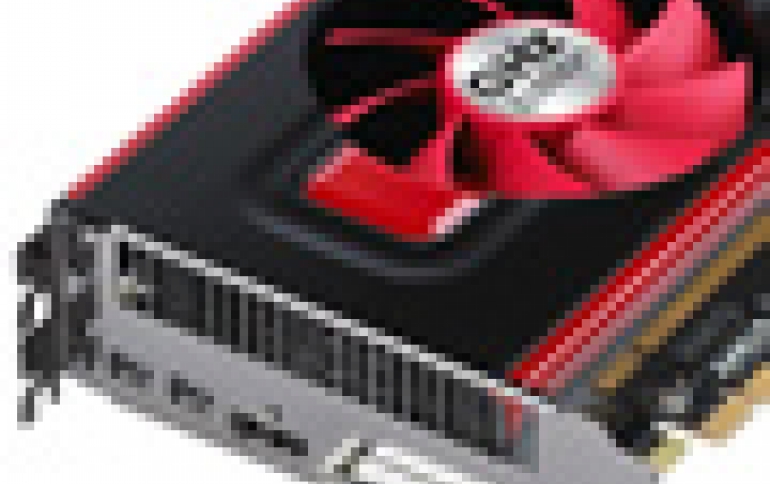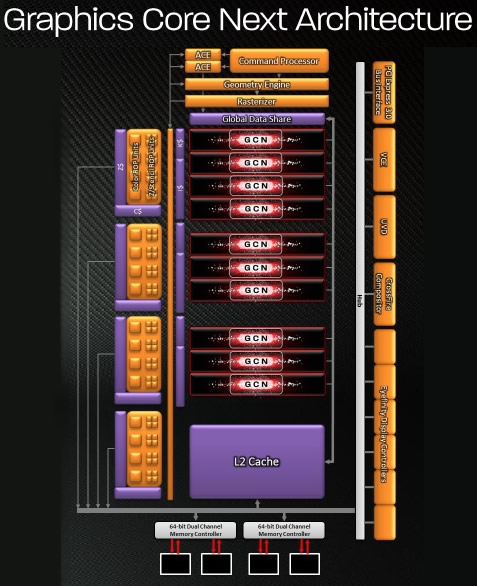
AMD Releases More Affordable 28nm Radeon HD 7700 Graphics Cards
AMD today announced the arrival of its AMD Radeon HD
7770 GHz Edition and HD 7750 graphics cards, based on
the company's 28nm Cape Verde GPU.
The AMD Radeon HD 7700 Series features AMD's new
Graphics Core Next (GCN) Architecture and comes
equipped with PCI Express 3.0, AMD ZeroCore Power,
PowerTune, AMD Eyefinity 2.0 and AMD App
technologies.

Cape Verde is AMD's smallest 28nm GPU. With a die size of 123mm2 it's only a hair bigger than the 118mm2 Turks GPU that powers the 6600 series. The new GPU has 10 Compute Units, giving Cape Verde 640 SPs and 40 texture units. Cape Verde also packs 16 ROPs, 1 geometry engine/rasterizer pair, and 512KB of L2 cache, with the chip coupled to a 128bit GDDR5 memory bus. Altogether compared to Tahiti this is around 31% of the CUs, 33% of the memory bus width, and half as many ROPs.

Backing up Cape Verde will be DX10+ SSAA, PowerTune, Fast HDMI support, partially resident textures, D3D 11.1 support, and the still-AWOL Video Codec Engine (VCE).
Today AMD will be launching two cards: the Radeon HD 7750, and the Radeon HD 7770 GHz Edition.

The 7770 is a fully enabled Cape Verde with all 10 CUs (640 SPs) enabled, running at 1GHz for the core clock and 4.5GHz for the memory clock, with a PowerTune limit of 100W and an AMD defined typical board power of 80W.
For display connectivity AMD is using the same configuration as we've seen on the 7900 series: 1 DL-DVI port, 1 HDMI port, and 2 miniDP ports.

The 7750 meanwhile has 2 disabled CUs, giving it 512 SPs and 32 texture units, while the ROP count is unchanged at 16. The core clock will be 800MHz while the memory clock is the same as the 7770 at 4.5GHz, with a PowerTune limit of 75W and a typical board power of 55W. Both cards have a sub-10W idle TDP, while long-idle is sub-3W.
For display connectivity, AMD's card has 1 DL-DVI port, 1 HDMI port, and 1 full size DisplayPort instead of the miniDP we 've seen inprevious cards.

The graphics cards are available today via retailers and e-tailers worldwide, with select models of the AMD Radeon HD 7770 GHz Edition 1GB starting at USD$159 SEP, and the AMD Radeon HD 7750 1GB starting at USD$109 SEP.
The AMD Radeon HD 7700 series GPUs will be available worldwide from Sapphire, Powercolor, HIS, XFX, ASUS, Gigabyte, and MSI.
According to reviews published online so far, the low-power 7750 generally comes off slightly better, especially for those looking to build a budget or HTPC rig. Both cards seems to offer a good power-to-performance ratio. Compared to Nvidia's GeForce GTX560 and 550, AMD's new cards seems to offer you less in terms of gaming power but still, they are more affordable.

Cape Verde is AMD's smallest 28nm GPU. With a die size of 123mm2 it's only a hair bigger than the 118mm2 Turks GPU that powers the 6600 series. The new GPU has 10 Compute Units, giving Cape Verde 640 SPs and 40 texture units. Cape Verde also packs 16 ROPs, 1 geometry engine/rasterizer pair, and 512KB of L2 cache, with the chip coupled to a 128bit GDDR5 memory bus. Altogether compared to Tahiti this is around 31% of the CUs, 33% of the memory bus width, and half as many ROPs.

Backing up Cape Verde will be DX10+ SSAA, PowerTune, Fast HDMI support, partially resident textures, D3D 11.1 support, and the still-AWOL Video Codec Engine (VCE).
Today AMD will be launching two cards: the Radeon HD 7750, and the Radeon HD 7770 GHz Edition.

The 7770 is a fully enabled Cape Verde with all 10 CUs (640 SPs) enabled, running at 1GHz for the core clock and 4.5GHz for the memory clock, with a PowerTune limit of 100W and an AMD defined typical board power of 80W.
For display connectivity AMD is using the same configuration as we've seen on the 7900 series: 1 DL-DVI port, 1 HDMI port, and 2 miniDP ports.

The 7750 meanwhile has 2 disabled CUs, giving it 512 SPs and 32 texture units, while the ROP count is unchanged at 16. The core clock will be 800MHz while the memory clock is the same as the 7770 at 4.5GHz, with a PowerTune limit of 75W and a typical board power of 55W. Both cards have a sub-10W idle TDP, while long-idle is sub-3W.
For display connectivity, AMD's card has 1 DL-DVI port, 1 HDMI port, and 1 full size DisplayPort instead of the miniDP we 've seen inprevious cards.

The graphics cards are available today via retailers and e-tailers worldwide, with select models of the AMD Radeon HD 7770 GHz Edition 1GB starting at USD$159 SEP, and the AMD Radeon HD 7750 1GB starting at USD$109 SEP.
The AMD Radeon HD 7700 series GPUs will be available worldwide from Sapphire, Powercolor, HIS, XFX, ASUS, Gigabyte, and MSI.
According to reviews published online so far, the low-power 7750 generally comes off slightly better, especially for those looking to build a budget or HTPC rig. Both cards seems to offer a good power-to-performance ratio. Compared to Nvidia's GeForce GTX560 and 550, AMD's new cards seems to offer you less in terms of gaming power but still, they are more affordable.





















